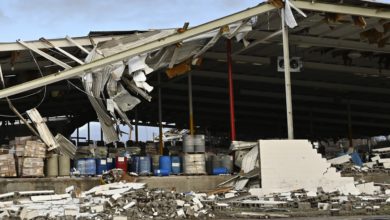The Centers for Disease Control and Prevention relaxed mask recommendations for most Americans on Friday, releasing a color-coded map to help residents determine if they should wear masks indoors in their area.
The CDC announced new COVID-19 metrics Friday, which now place about 70% of the U.S. population — or 63% of U.S. counties — in areas of low or medium risk of COVID. In those areas, the CDC has dropped its recommendation for universal indoor masking.
For people in areas where the risk of COVID is higher, the CDC still advises everyone wear masks in indoor public places. About 37% of U.S. counties, or 28% of Americans, fall under this category.
To calculate local COVID risk, the CDC is now considering hospitalizations, current beds occupied by COVID patients and hospital capacity — in addition to the case numbers, which previously dominated its metrics.
To find out which category your county falls under, a CDC map has color-coded each U.S. county as orange, yellow or green.
Health experts say the new guidance may be a first step in shifting the U.S. to an “endemic phase” of the pandemic. The nation has now reported a week of COVID-19 cases under 100,000 a day for the first time in seven months, according to USA TODAY analysis of Johns Hopkins University data.
Cases in the U.S. are once again averaging less than 70,000 per day, a figure not seen since last summer when the delta variant-driven wave swept the South and began pounding the North, and before the omicron variant caused unprecedented levels of COVID nearly everywhere in the country.
Also in the news:
►Rep. Lauren Underwood of Illinois has tested positive for COVID-19 after returning from travel overseas, the second-term Democrat said Friday. She said she has mild symptoms.
►New York City public school students will be allowed to remove their masks outside starting next week but must keep them on indoors for now, Schools Chancellor David Banks said Friday.
►Wisconsin prisons will allow in-person visits again beginning next week as COVID-19 cases continue to decline. Prisons were closed since December's omicron surge, while the department offered inmates two free phone calls per week and installed video conferencing systems to help inmates stay in touch with loved ones.
►New Jersey hospital executives have asked Gov. Phil Murphy to delay Monday's deadline for all health care workers to get a COVID booster shot as tens of thousands of their employees have still not received one.
📈Today's numbers: The U.S. has recorded more than 78.9 million confirmed COVID-19 cases and 947,800 deaths, according to Johns Hopkins University data. Global totals: More than 433.6 million cases and 5.9 million deaths. More than 215.3 million Americans – 64.9% – are fully vaccinated, according to the Centers for Disease Control and Prevention.
📘 What we're reading: After Canada, U.S. truckers decided to start their own 'convoys.' What are they protesting? Read the full story.
Keep refreshing this page for the latest news. Want more? Sign up for USA TODAY's free Coronavirus Watch newsletter to receive updates directly to your inbox and join our Facebook group.
Ukraine faces 'very high' COVID cases amid Russian invasion
As Russia launches a full-scale attack on Ukraine, the country is also grappling with public health threats including COVID-19 and a polio outbreak. As people gather in shelters and attempt to flee the country, the spread of COVID-19 may worsen.
Jarno Habicht, the World Health Organization representative in Ukraine, said at a Friday news conference that the number of COVID-19 cases in Ukraine continues to be "very high."
"We are still in the most difficult COVID times currently," he said, adding that hospitalizations and deaths are still lower than in past waves of the virus.
The country, which is about 35% fully vaccinated, saw more than 150,000 new cases in the past week, according to recent Johns Hopkins University data.
Meanwhile, the country has also been contending with a polio outbreak since October when the virus was found in a 17-month-old girl who was experiencing paralysis, according to the WHO. The WHO noted that there was a high risk of national spread due to "historically low immunization coverage rates in Ukraine."
Treasury department releases breakdown of who got COVID rental aid
More than 80% of the billions of dollars in federal rental assistance aimed at keeping families in their homes during the pandemic went to low-income tenants, the Treasury Department said.
It also concluded Thursday that the largest percentage of tenants receiving pandemic aid were Black followed by female-led households. In the fourth quarter of 2021, Treasury found that more than 40% of tenants getting help were Black and two-thirds of recipients were female-headed households. The data was consistent with what Treasury saw throughout the year.
According to the Eviction Lab at Princeton University, those most likely to face eviction are low-income women, especially women of color. Domestic violence victims and families with children are also at high risk for eviction.
“It’s really encouraging to see so much of the rental assistance reaching those most in need: women, Black renters, and low-income households in particular,” Peter Hepburn, a research fellow at the Eviction Lab, said. “These are the groups that face highest risk of eviction and who were most severely affected by the economic impacts of the pandemic. They’re the ones that this money was meant to help.”
— The Associated Press
Neighborhood inequality shaped the pandemic, study finds
A new study reveals how neighborhood mobility might have helped shape the first year of the COVID-19 pandemic in Wisconsin and two cities, San Francisco and Seattle.
Researchers used COVID infection data for 2,000 census tracts within the three locations and compared it with a dataset of 45 million de-identified cellphone records to show where people traveled. The analysis looked at infection data prior to vaccines being available.
“If poverty and other things like that tend to correlate with COVID-19 infection risk, then it's plausible that being attached to high-poverty neighborhoods is likely to increase your risk for COVID-19," said Brian L. Levy, the study's lead author who is an assistant professor at George Mason University. "And that's what we found.”
In Wisconsin, a high-poverty neighborhood where residents visited and were visited by residents of other high-poverty neighborhoods had an infection rate that was 25% higher than an affluent neighborhood with a strong connection with other affluent neighborhoods.
The findings suggest the neighborhoods that yours is attached to through visits might be more important than the characteristics of your own neighborhood, such as income and education level, Levy said.
— Ashley Luthern, Milwaukee Journal Sentinel
COVID tests among favors being passed out ahead of Mardi Gras
Attendees at Mardi Gras parades are used to catching beads thrown out by parade floats, but this year they're also snagging COVID tests.
As Carnival season nears its raucous pre-Lenten climax on Mardi Gras (Fat Tuesday) next week, the handing out of tests during the Krewe of Muses parade is emblematic of the city’s effort to avoid a surge of COVID-19 infections, hospitalizations and deaths while reviving cherished, and economically vital, Carnival events. Those events were largely silenced in 2021 after officials realized the 2020 celebration had been a “superspreader” event that made Louisiana an early Southern hot spot for the disease.
“COVID is not over yet, and we need to use every tool at our disposal to prevent a repeat of the tragedies of Mardi Gras 2020.”
Though COVID cases have been on the decline after the peak of omicron, New Orleans is still requiring masks indoors and proof of vaccination or a recent negative test to access many public spaces.
Contributing: The Associated Press
Source link








